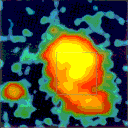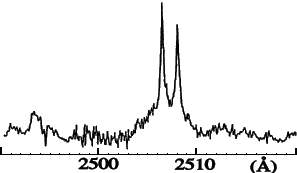![[ Optical image of Eta Carinae ]](EtaCarinae.jpg) |
Eta CarinaeHubble Space Telescope image of unstable star Eta Carinae, note the double lobed structure of the expanding stellar atmosphere. This bipolar structure is similar to that of other laser stars. |
![[ Optical image of Eta Carinae ]](EtaCarinae.jpg) |
Eta CarinaeHubble Space Telescope image of unstable star Eta Carinae, note the double lobed structure of the expanding stellar atmosphere. This bipolar structure is similar to that of other laser stars. |
Darth Vader take heart. Astronomers have discovered a powerful ultraviolet laser beam, several times brighter than our Sun, shooting toward Earth from a super-hot "death star."
The observations, made with NASA's Hubble Space Telescope have identified a gas cloud that acts as a natural ultraviolet laser, near the huge, unstable star called Eta Carinae -- one of most massive and energetic stars in our Milky Way Galaxy. The interstellar laser may result from Eta Carinae's violently chaotic eruptions, in which it blasts parts of itself out into space, like an interstellar geyser.
Sveneric Johansson, a specialist in atomic spectroscopy at the University of Lund in Sweden, has been analyzing Hubble Space Telescope observations of Eta Carinae, made with the Goddard High-Resolution Spectrograph (GHRS). Johansson reports that his interpretation is not yet proven, but that it appears to be the most plausible explanation of the data.
A laser, (which is an acronym for Light Amplification by Stimulated Emission of Radiation) creates an intense coherent beam of light when atoms or molecules in a gas, liquid or solid medium, force an incoming mix of wavelengths (or colors) of light to work in phase, or, at the same wavelength. Laser light is analogous to a loud, single-pitch note, while normal white light is analogous to audio static on a radio.
The ultraviolet laser in Eta Carinae shines by the same physics that led to the invention of artificial optical lasers in 1960 and similar, microwave devices called masers, in 1954. Natural masers have been seen in space since the mid-1960s, and an infrared laser was discovered around the hot young star MWC 349, earlier this year.
"Each ultraviolet light particle (photon) generated in the Eta Carinae laser has almost 700 times the energy of a photon in MWC 349, and so the total energy output is far greater," said Kris Davidson of the University of Minnesota. "Natural infrared lasers are very rare in space; this ultraviolet laser is even more difficult for nature to arrange, and nothing like it has been seen before."
Eta Carinae is several million times brighter than the Sun, and one hundred times as massive. The superstar, located 8,000 light-years away underwent a colossal outburst 150 years ago. Radio and X-ray astronomers have recently detected smaller outbursts in gas around the star :
 |
X-Ray Pulse !Two frame animation of the strong X-Ray outburst in Eta Carinae detected by the ROSAT satellite (Courtesy Michael Corcoran, Universities Space Reasearch Association) |
Previous HST observations found that the gas from the earlier giant explosion now forms a bizarre double-lobed nebula pinched in the center by a ragged equatorial disk.
In a Hubble Space Telescope investigation led by Davidson, including nine other collaborators in the U.S., Germany, and Sweden, ultraviolet light from the same gas is being closely studied. (This ultraviolet emission is in the wavelength range that is absorbed by the Earth's ozone layer, and hence must be studied from space).
Team member Johansson was particularly interested in emission by iron ions that seemed unnaturally bright in the new data. He has found the only plausible explanation of the relative brightness of the iron emission lines is a natural laser emitting at energetic ultraviolet light. "The spectrum of singly-ionized iron (an iron atom with one electron removed) has almost a thousand known energy states and some of these are apparently well-suited to making a laser effect," said Davidson.
The gas was ejected along the equatorial plane of Eta Carinae about 100 years ago. Moving outward at about 100 thousand miles per hour, the gas is now about 60 billion miles, (100 billion kilometers), or 700 times the distance between Earth and the Sun.
The discovery could provide scientists with a new tool for studying gas recently shot out of unstable stars, interactions of radiation with atoms in space, and atomic structure in cosmic gas clouds.
The researchers are planing to use Hubble's Faint Object Spectrograph to observe the same gas, covering a wider range of wavelengths than the GHRS data. This will hopefully lead to a better understanding of how the monster laser actually works.
FOR RELEASE: January 10, 1995
CONTACT: Ray Villard
Space Telescope Science Institute, Baltimore, MD
(Phone: 410-338-4514)
Sveneric Johansson
University of Lund, Sweden
(Phone: 46-4612-6097)
Kris Davidson
University of Michigan, Minneapolis
(Phone: 612-624-5711)
PRESS RELEASE NO.: STScI-PR96-06

In 1837 it became one of the brightest stars in the sky. Even today it is the brightest object in the whole sky at infrared wavelengths of 20 microns. This indicate a thick circumstellar shell of dust and gas. Its late type spectrum combined with nova-like emission line characteristics such as P-Cygni and helium lines make this star 'one of the more unusual emission-line spectra of any celestial object' (according to Hearnshaw, 1986). Stellar plasma expansion velocities of several hundreds of kilometers per second have been detected.